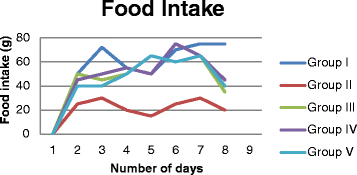Cytotoxicity and hepatoprotective attributes of methanolic extract of Rumex vesicarius L
- PMID: 25857314
- PMCID: PMC4384386
- DOI: 10.1186/s40659-015-0009-8
Cytotoxicity and hepatoprotective attributes of methanolic extract of Rumex vesicarius L
Abstract
Background: To evaluate the hepatoprotective potential and invitro cytotoxicity studies of whole plant methanol extract of Rumex vesicarius L. Methanol extract at a dose of 100 mg/kg bw and 200 mg/kg bw were assessed for its hepatoprotective potential against CCl4-induced hepatotoxicity by monitoring activity levels of SGOT (Serum glutamic oxaloacetic transaminase), SGPT (Serum glutamic pyruvic transaminase), ALP (Alkaline phosphatase), TP (Total protein), TB (Total bilirubin) and SOD (Superoxide dismutase), CAT (Catalase), MDA (Malondialdehyde). The cytotoxicity of the same extract on HepG2 cell lines were also assessed using MTT assay method at the concentration of 62.5, 125, 250, 500 μg/ml.
Results: Pretreatment of animals with whole plant methanol extracts of Rumex vesicarius L. significantly reduced the liver damage and the symptoms of liver injury by restoration of architecture of liver. The biochemical parameters in serum also improved in treated groups compared to the control and standard (silymarin) groups. Histopathological investigation further corroborated these biochemical observations. The cytotoxicity results indicated that the plant extract which were inhibitory to the proliferation of HepG2 cell line with IC50 value of 563.33 ± 0.8 μg/ml were not cytotoxic and appears to be safe.
Conclusions: Rumex vesicarius L. whole plant methanol extract exhibit hepatoprotective activity. However the cytotoxicity in HepG2 is inexplicable and warrants further study.
Figures



Similar articles
-
Antioxidant and hepatoprotective activity of Fagonia schweinfurthii (Hadidi) Hadidi extract in carbon tetrachloride induced hepatotoxicity in HepG2 cell line and rats.J Ethnopharmacol. 2013 Dec 12;150(3):973-81. doi: 10.1016/j.jep.2013.09.048. Epub 2013 Oct 17. J Ethnopharmacol. 2013. PMID: 24140589
-
Hepatoprotective naphthalene diglucoside from Neanotis wightiana aerial parts.Phytomedicine. 2017 Sep 15;33:14-20. doi: 10.1016/j.phymed.2017.07.002. Epub 2017 Jul 4. Phytomedicine. 2017. PMID: 28887915
-
Ameliorative effect of methanol extract of Rumex vesicarius on CCl4-induced liver damage in Wistar albino rats.Pharm Biol. 2015 Aug;53(8):1163-7. doi: 10.3109/13880209.2014.967782. Epub 2015 Feb 23. Pharm Biol. 2015. PMID: 25702903
-
Investigation of hepatoprotective activity of Cyathea gigantea (Wall. ex. Hook.) leaves against paracetamol-induced hepatotoxicity in rats.Asian Pac J Trop Biomed. 2012 May;2(5):352-6. doi: 10.1016/S2221-1691(12)60055-0. Asian Pac J Trop Biomed. 2012. PMID: 23569929 Free PMC article.
-
Hepatoprotective and antioxidant activity of methanolic extract of flowers of Nerium oleander against CCl4-induced liver injury in rats.Asian Pac J Trop Med. 2012 Sep;5(9):677-85. doi: 10.1016/S1995-7645(12)60106-0. Asian Pac J Trop Med. 2012. PMID: 22805717
Cited by
-
In vivo Hepatoprotective and in vitro Radical Scavenging Activities of Extracts of Rumex abyssinicus Jacq. Rhizome.J Exp Pharmacol. 2020 Aug 5;12:221-231. doi: 10.2147/JEP.S258566. eCollection 2020. J Exp Pharmacol. 2020. PMID: 32821176 Free PMC article.
-
In Vitro Assessment of the Interaction Potential of Ocimum basilicum (L.) Extracts on CYP2B6, 3A4, and Rifampicin Metabolism.Front Pharmacol. 2020 Apr 30;11:517. doi: 10.3389/fphar.2020.00517. eCollection 2020. Front Pharmacol. 2020. PMID: 32425779 Free PMC article.
-
Antipyretic and hepatoprotective potential of Tinospora crispa and investigation of possible lead compounds through in silico approaches.Food Sci Nutr. 2019 Dec 23;8(1):547-556. doi: 10.1002/fsn3.1339. eCollection 2020 Jan. Food Sci Nutr. 2019. PMID: 31993178 Free PMC article.
-
Medicinal herbs and their metabolites with biological potential to protect and combat liver toxicity and its disorders: A review.Heliyon. 2024 Feb 1;10(3):e25340. doi: 10.1016/j.heliyon.2024.e25340. eCollection 2024 Feb 15. Heliyon. 2024. PMID: 38356556 Free PMC article. Review.
-
The genus Rumex (Polygonaceae): an ethnobotanical, phytochemical and pharmacological review.Nat Prod Bioprospect. 2022 Jun 16;12(1):21. doi: 10.1007/s13659-022-00346-z. Nat Prod Bioprospect. 2022. PMID: 35710954 Free PMC article. Review.
References
-
- Shahani S. Invivo evaluation of hepatoprotective efficacy of APCL-polyherbal formulation in rats. Indian Drugs. 1999;36:628–31.
-
- Dianzani MU, Muzio G, Biocca ME, Canuto RA. Lipid peroxidation in fatty liver induced by caffeine in rats. Int J Tissue React. 1991;13:79–85. - PubMed
Publication types
MeSH terms
Substances
LinkOut - more resources
Full Text Sources
Other Literature Sources
Medical
Miscellaneous

